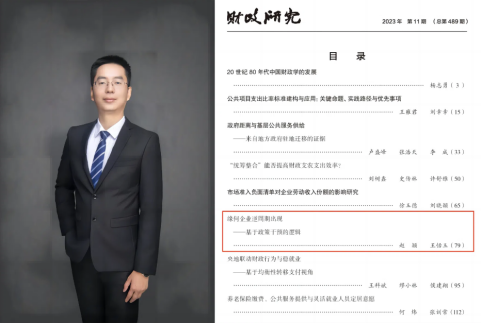
[Academic Journal] Public Finance Research, Issue 11, 2023.
[About the Author] Zhao Ying, Associate Professor, Master Supervisor and Associate Doctoral Supervisor of the School of Public Finance and Taxation, Zhongnan University of Economics and Law (ZUEL). His research focuses on public sector economics and development economics. He was the Candidate of the Hubei Provincial Key Talent Project, the Xiangjiang Scholar Program, the Hubei Province Postdoctoral Talent Tracking and Cultivation Program, and the Young Scholar of the "Wenlan Scholar Program". He has published papers as the sole or first author in journals such as Economic Research Journal (3 articles), Journal of Management World, China Industrial Economics, Journal of Financial Research, and China & World Economy. He has led more than 10 projects, including the General Program (2 programs) and Youth Program (1 program) of National Natural Science Foundation of China, and Humanities and Social Sciences Projects of the Ministry of Education. He has won the first prize of the Hubei Province Outstanding Research Award and the first prize of the 16th Wuhan Social Science Achievement Award. He is an anonymous reviewer for leading journals such as China Economic Review, China & World Economy, Economic Research Journal, Journal of Management World, China Economic Quarterly, China Industrial Economics, and Journal of Financial Research. He also serves as a correspondence review expert of the projects of National Natural Science Foundation of China, and a review expert of Ministry of Science and Technology of China and State Administration of Foreign Experts Affairs.
[Main Views] This study utilizes a comprehensive dataset of all newly established market entities from 2007 to 2009. By employing a difference-in-differences research design, it explores the causes and characteristics of counter-cyclical enterprise entry. Research Findings: (1) Intervention policies significantly promote the counter-cyclical emergence of firms, and a series of robustness checks confirm the reliability of this conclusion; (2) The underlying mechanism lies in the improvement of market credit financing and the continuous enhancement of the level of division of labor; (3) During this process, firms' interconnectivity increases, particularly with collective and state-owned enterprises. The logic of policy intervention can effectively explain the phenomenon of countercyclical entry. However, the tendency of the state-owned enterprise bias in the allocation of market resources leading to an increasing linkage between firms and stated-owned enterprises also needs to be given sufficient attention.
The main contributions of this paper are threefold: First, it explains the logic of firms' countercyclical entry from the perspective of firm associations, enhancing the existing literature that interprets enterprise entry through social division of labor and transaction costs. Second, it addresses the impact of government intervention on key market factors from the perspective of enterprise entry, which is different from the existing literature that focuses on the impact of government intervention on remaining enterprises. Third, the samples cover all market entities, expanding beyond the limitations of previous studies that focused on specific types of firms.
Based on the conclusions of this paper, the policy recommendations are as follows: First, reduce bias in resource allocation. It is necessary to strengthen the decisive role of the market in resource allocation and reduce the distortion caused by biased resource allocation on the relationship between enterprises. Second, guide enterprises association properly. The government needs to maintain necessary attention to corporate associations or groupings and provide appropriate guidance to prevent companies from excessively leveraging their connections to capture the benefits of public policies. Third, the government should focus on expanding the market size, rather than relying on short-term stimulus to the market. This approach also requires the government to actively address market deficiencies, improve institutional development during the market operation process, and implement necessary counter-cyclical management.
